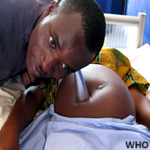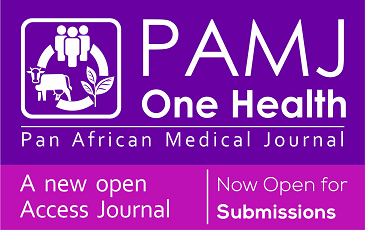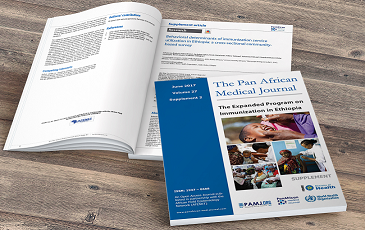Profiling lifetime episodes of upper gastrointestinal bleeding among patients from rural Sub-Saharan Africa where schistosoma mansoni is endemic
Christopher Kenneth Opio, Francis Kazibwe, Ponsiano Ocama, Lalitha Rejani, Elena Nikolaevna Belousova, Paul Ajal
Corresponding author: Christopher Kenneth Opio, Senior Lecturer, Department of Medicine, Makerere University College of Health Sciences, P.O. Box 7072, Kampala, Uganda 
Received: 01 May 2016 - Accepted: 21 Jul 2016 - Published: 03 Aug 2016
Domain: Clinical medicine
Keywords: Upper gastrointestinal bleeding, Sub-Saharan Africa, hepatic schistososomiasis
©Christopher Kenneth Opio et al. Pan African Medical Journal (ISSN: 1937-8688). This is an Open Access article distributed under the terms of the Creative Commons Attribution International 4.0 License (https://creativecommons.org/licenses/by/4.0/), which permits unrestricted use, distribution, and reproduction in any medium, provided the original work is properly cited.
Cite this article: Christopher Kenneth Opio et al. Profiling lifetime episodes of upper gastrointestinal bleeding among patients from rural Sub-Saharan Africa where schistosoma mansoni is endemic. Pan African Medical Journal. 2016;24:296. [doi: 10.11604/pamj.2016.24.296.9755]
Available online at: https://www.panafrican-med-journal.com/content/article/24/296/full
Original article 
Profiling lifetime episodes of upper gastrointestinal bleeding among patients from rural Sub-Saharan Africa where schistosoma mansoni is endemic
Profiling lifetime episodes of upper gastrointestinal bleeding among patients from rural Sub-Saharan Africa where schistosoma mansoni is endemic
Christopher Kenneth Opio1,&, Francis Kazibwe2, Ponsiano Ocama1, Lalitha Rejani1, Elena Nikolaevna Belousova3, Paul Ajal4
1Makerere University, College of Health Sciences, P.O.Box 7072, Kampala, Uganda, 2Bishop Stuart University, Public Health Department, P.O.Box 9, Mbarara, Uganda, 3Kazan University, Russian Federation, 4Pakwach Health Centre IV, Ministry of Health, Pakwach, Uganda
&Corresponding author
Christopher Kenneth Opio, Senior Lecturer, Department of Medicine, Makerere University College of Health Sciences, P.O. Box 7072, Kampala, Uganda
Introduction: severe severe chronic hepatic schistosomiasis is a common cause of episodes upper gastrointestinal bleeding (UGIB) in sub-Saharan Africa (SSA). However, there is paucity of data on clinical epidemiology of episodes of UGIB from rural Africa despite on going public health interventions to control and eliminate schistosomiasis.
Methods: through through a cross sectional study we profiled lifetime episodes of upper gastrointestinal bleeding and associated factors at a rural primary health facility in sub-Saharan Africa were schistosomiasis is endemic. The main outcome was number of lifetime episodes of UGIB analyzed as count data.
Results: from from 107 enrolled participants, 323 lifetime episodes of UGIB were reported. Fifty-seven percent experienced ≥ 2 lifetime episodes of UGIB. Ninety-four percent had severe chronic hepatic schistosomiasis and 80% esophageal varices. Alcohol use and viral hepatitis was infrequent. Eighty-eight percent were previously treated with praziquantel and 70% had a history of blood transfusion. No patient had ever had an endoscopy or treatment for prevention of recurrent variceal bleeding. Multivariable analysis identified a cluster of eight clinical factor variables (age ≥ 40, female sex, history of blood transfusion, abdominal collaterals, esophageal varices, pattern x periportal fibrosis, anemia, and thrombocytopenia) significantly associated (P-value < 0.05) with increased probability of experiencing two or more lifetime episodes of UGIB in our study.
Conclusion: upper gastrointestinal bleeding is a common health problem in this part of rural SSA where schistosomiasis is endemic. The clinical profile described is unique and is important for improved case management, and for future research.
Upper gastrointestinal bleeding (UGIB) is a common worldwide health problem associated with substantial health care cost, morbidity, and death [1-4]. Patients with UGIB may experience one or more lifetime episodes of UGIB. Each new episode of UGIB increases one’s risk of morbidity and death. Among the causes of upper gastrointestinal bleeding, variceal upper gastrointestinal bleeding or UGIB due malignancy have the highest mortality [5]. Variceal upper gastrointestinal bleeding, a complication of portal hypertension is the most frequent type of upper gastrointestinal bleeding in sub Saharan Africa [6-9]. The usual causes of portal hypertension include schistosomiasis mansoni (through periportal fibrosis) and liver cirrhosis (due to chronic viral hepatitis, alcoholic liver disease, and others) [10-13]. In the absence of treatment up to 50% with severe chronic hepatic schistosomiasis of Mansoni type and/or chronic viral hepatitis will develop esophageal varices and more than half will experience upper gastrointestinal bleeding during their lifetime. In liver cirrhosis, 4 of 10 that develop acute variceal UGIB will die at 6 weeks, one-third re-bleed thereafter, and only one-third survive beyond 1 year [11,14]. The outcome is much better in UGIB due to schistosomiasis. In this group, 50 to 70% of those who experience their first episode of UGIB will go on to experience more episodes of bleeding over 5 years and one-third will die as a result of bleeding during the same period [15–20]. However, treatment of varices with drugs, bands, and shunts is shown to prevent further episodes of UGIB [21-23]. On the other hand, there is paucity of data on clinical epidemiology of lifetime episodes of upper gastrointestinal bleeding from rural Africa where schistosomiasis is endemic. We studied patients with one or more episodes of UGIB and determined the factors associated with number of lifetime events among patients presenting at a rural primary health facility in sub Saharan Africa. Our specific study objective was to determine the clinical, laboratory and ultrasound findings associated with increased probability of experiencing two or more episodes of UGIB is this part of rural SSA.
Ethics statement
This was routine cross sectional study that involved human participants. It was approved by School of Medicine, Makerere University, Institutional review board, Kampala, Uganda (#REC REF2011-244), and the Uganda National Council for Science and Technology, Kampala, Uganda (UNCST approval #, HS 1620). The study was conducted according to the principles expressed in the Declaration of Helsinki. Written informed consent was obtained from all participants.
Study site and study population This was a cross sectional descriptive and analytic study among patients reporting at least one life time episode of UGIB, aged 12 years and above who presented at Pakwach Health Centre IV over the study period 14th July to 30th august 2014. Pakwach Health Centre IV is located in rural Uganda at banks of the Albert Nile River. The prevalence of schistosomiasis due to S. mansoni in this region is reported at over 50% and facility records report a relatively high frequency of patients with UGIB. Generally, 30 patients above the age of 5 years are seen at outpatients daily and about 4 to 5 adult patients, not including pregnant women are admitted every day. Data from the Uganda national health management information systems for the year 2012/13 recorded 24,222 outpatient visits and 5532 inpatient admissions.
Sample size estimation
Sample size for this cross sectional study design was estimated at 102 participants (n) using a power (a) of 90%, p=15%, N= 285, d= 5% using the formula, n = [(N p (1-p)]/ [(d2/Z21-a/2*(N-1)+p*(1-p)]. Where p is the proportion of patients estimated to develop upper gastrointestinal bleeding due to varices, N is the number patients from this health facility meeting our inclusion criteria in a year, Z is the Z-score, and d is the confidence limits.
Enrolment procedures and data collection
Screening and enrolment were carried during the working week. Patients receiving care at the outpatients and in patient departments at Pakwach health Centre IV were assessed for eligibility. The inclusion criteria comprised aged 12 years and above, written informed consent /assent, and reporting at least one lifetime episode of UGIB. Participants with any absolute or relative contraindication to un-sedated diagnostic upper gastrointestinal endoscopy were excluded from the study. These comprised pregnant women, patients requiring or under resuscitation, and those unable to tolerate the procedure. During screening we employed systematic sampling at outpatients (skipped the first three registered patients and approached every other patient aged 12 years and over) and for ethical reasons recruited all eligible inpatients with acute upper gastrointestinal bleeding (AUGIB) after resuscitation and stabilization during the study period since they would benefit from endoscopy. In the study, UGIB was defined as a lifetime of any of the following: hematemesis and melena or blood in stool as reported by the eligible study participant. However, the main outcome for this study was number of lifetime episodes of UGIB reported by a participant. We recorded socio-demographic data, exposure to schistosoma species or alcohol, treatment of schistosomiasis and time from the last treatment, history of UGIB, related past medical, or drug treatment history, stigmata of chronic liver disease, vital signs, 3-part hematology indices (using compact Sysmex KX-21 hematology analyzer), hepatitis B and C viral blood serology results (obtained by commercially available rapid diagnostic test kits), malaria antigen test results (by rapid diagnostic test kits), stool microscopy for ova, urine circulating cathodic antigen (CCA) test by Rapid diagnostics, and ultrasound findings performed by a trained sonographer according to the modified World Health Organization Niamey protocol. Trans-abdominal ultrasound was performed using the SONOSTAR model SS8, portable ultrasound with a 3.5 MHz convex probe. All participants were then scheduled for diagnostic upper digestive endoscopy that was performed using Pentax EPKi digital video processor and Pentax 9.8 mm video gastroscope for diagnosis. At the commencement of the procedure the patient was gowned, he or she was asked to sit on the procedure bed and xylocaine oral spray administered. He or she was then positioned in the left lateral position and a mouth gag inserted. The oesophagus, stomach, and duodenum were examined for evidence suggestive of UGIB or cause of UGIB with special emphasis on varices, oesophageal or gastric erosions or ulcers. Endoscopic findings were assessed and reported as recommended by the Japanese Research For Portal Hypertension [24] and /or the modified Forrest classification upper gastrointestinal bleeding [25] in the clinical report form.
Data management and analysis
Data obtained from these study procedures was recorded into a clinical report form and transcribed into Microsoft Access database software 2007 (Microsoft corporation) on a daily basis. This was later edited to ensure quality and exported to Stata version 13 (STATACorp, Lakeway, College Station, Texas, USA). Within Stata, descriptive and inferential statistics were undertaken profiling the study population and factors associated with episodes of UGIB. Contingency tables summarizing the factor variables relative to the outcome were generated and inference determined by likelihood ratio Chi-square test. Further statistical inference was determined by negative binomial multivariate analysis of the count data with robust estimator of variance. A significance level (p-value < 0.05) was considered, confidence intervals supported inference, and beta coefficients provided a measure of how strongly each factor variable influenced the outcome variable. Selection of the best-fit models was criterion based. Results of the best-fit model (the model with the lowest Akaike information criterion-AIC, and Bayesian information criterion-BIC) were then subject to marginal analysis and which are summarized as a graph. These results are presented in the body of the manuscript, as tables, and as figures.
Over a period of 6 weeks (July 2014 to August 2014), one hundred and seven participants were enrolled. With exception of one participant that reported once a week contact with the waters of the Nile, all other reported 5-7 times a week contacts with the waters of the Nile. Twenty-three were in patients with acute severe UGIB, and 84 outpatients with a past history of UGIB. The prevalence of UGIB among screened at outpatients was 24%; 95%CI (20%-29%). The age range of participants was 25 to 71 years. Sixty percent were females and 96% reported ever experiencing hematemesis. The rest reported melena or hematochesia without hematemesis. The total number of episodes of UGIB reported in the study was 323 episodes. Sixty-one (57%) participants experienced two or more episodes of UGIB during their lifetime and the rest reported experiencing only one episode of UGIB during their lifetime. Seventy-five percent of the study participants experienced their first episode of UGIB within 5 years of enrollment. Ninety-six percent were ever admitted for UGIB, no participant had ever had an endoscopy for their UGIB and 73% previously received blood transfusion for UGIB. Severe chronic hepatic schistosomiasis was diagnosed with certainty in 101 (94%) participants, however alcohol use, serological markers of chronic viral hepatitis, and active infection with schistosoma mansoni were not that frequent. Notably, 78% of our study participants had received praziquantel for treatment of schistosomiasis in the last 12 months. With exception of splenomegaly that was found among 92(90%) participants, stigmata of chronic liver disease were not frequent in our study. More than 50% of our participants had anemia (hemoglobin level< 110g/L) and thrombocytopenia (platelet count < 150x109/L). Esophageal varices were the most common endoscopic finding explaining UGIB and these was found among 80% of our study participants (Table 1).
Clinical factor variables by number of lifetime episodes of UGIB
The frequencies of lifetime episodes of UGIB among the 3 different categories of bleeding “1 episode”, “2 or 3 episodes”, “4 or more episodes”, were 46, 81, and 196 respectively. Participants who experienced more than one episode of UGIB were likely to have the following; aged =40 years, females, severe acute variceal bleeding, history of variceal bleeding, previous treatment with praziquantel, an enlarged spleen, ascites, abdominal collaterals, pattern X according to Niamey protocol, hemoglobin level =90g/L, platelet count = 35 x109/L cells, and esophageal varices at endoscopy. In contrast, participants with one episode of UGIB were likely to have a liver flap and a positive hepatitis B surface antigen test (Table 2).
Multivariable analysis output for the three best-fit models
We identified 3-fit models. Model-3 performed best since it demonstrated the lowest Akaike information criterion and Bayesian information criterion. Model-3 (n=68) included all the factor variables listed and limited to patients who received praziquantel in the last one year. In contrast, model-1 (n=88) included one-year treatment with praziquantel as a factor variable and model-2 (n=105) included all participants not correcting for treatment with praziquantel (Table 3). A summary of the regression coefficients, their standard errors, constants, p-values, and criterion are presented (Table 3).
Impact of factor variables on the number of lifetime episodes of UGIB for model-3
Average marginal effects were calculated from model-3 and presented as a graph, describing the positive impact of the various factor variables on the number of lifetime episodes of UGIB reported by our study participants (Figure 1). On average the presence of any of these factors variables in a participant would increase the individuals probability of experiencing two or more l lifetime episodes of UGIB (Figure 1).
Upper gastrointestinal bleeding is poorly described at primary health care facilities in rural Africa because weak health systems[26–28]. We studied at episodes of upper gastrointestinal bleed as reported by the patients to describe upper gastrointestinal bleeding at a rural primary health care facility. We found upper gastrointestinal bleeding was a common health problem at this primary health facility in rural sub Saharan Africa most participants reported more than 2 lifetime episodes of UGIB. Patient reported upper gastrointestinal bleeding was corroborated by endoscopy, abdominal ultrasound, and presence of anemia[29–31]. Endoscopy and ultrasound showed most participants had esophageal varices and/or meet the ultrasound criteria diagnostic of hepatic schistosomiasis. Moreover, similar findings have been reported by hospital-based studies from the same region[8,9,13,17,32]. In contrast, there was limited evidence to suggest UGIB in our study was mainly due to cirrhosis due to hepatitis or peptic ulcer disease. The study also identified a cluster of factor variables, which were associated with an increased probability of experiencing two or more episodes of UGIB in this population. We found an association between age =40years and number of episodes of UGIB. Others showed individuals aged over 35 years with schistosomiasis had the highest frequency of periportal fibrosis [33] and were 2 times more likely to develop UGIB [34]. We also found an association between female gender and likelihood of experiencing increasing episodes of UGIB. One study reported females are more likely to present with UGIB due to varices than males [35]. However, we do not have any clear explanation for this peculiar finding. A history of blood transfusion was one of the other factors associated with increasing episodes of UGIB. A number of studies show blood transfusion is associated with recurrent episodes of UGIB [36, 37]. It could be argued that each bleeding episode was a trigger for blood transfusion and since our patients were able to survive this long, the association that we are observing is just an accumulation of several events. On the other hand, some clinical trials show restricting blood transfusion among patients with UGIB was shown to reduce UGIB recurrences and mortality [37,38]. Periportal fibrosis, abdominal collaterals, esophageal varices, anemia, and thrombocytopenia are recognized causes or sequel of portal hypertension. All these factors have been associated with recurrent UGIB. Our findings are comparable with what has been reported by others [12,20,39–43]. The negative correlation of hepatitis B surface antigen or liver flap with increasing number of lifetime episodes of UGIB suggests patients with these factors may not have survived. This explanation is supported by two publications that indicate these two factors are associated with increased risk of death [44,45]. Our study had limitations. These are partly related to its cross sectional study design and the fact participants were selected from a single primary health care facility. Moreover, our study might have been exposed to recall bias because we relied on anamnesis to retrospectively reconstitute the first hand past experience of our participants. However our clinical findings, ultrasound, laboratory, and endoscopic were in keeping with the participant’s account of UGIB [30,46-49].
Our study high lights upper gastrointestinal bleeding is a common health problem in rural SSA. In addition, the study provides an up-to-date profile of UGIB in rural SSA where schistosomiasis is endemic. These are important findings for populations at risk of hepatic schistosomiasis, for better case management, improvement of health management information systems, and further research in SSA.
What is known about this topic
- Severe hepatic schistosomiasis and/or liver cirrhosis are the most common causes of upper gastrointestinal bleeding in sub Saharan Africa;
- Mass drug administration with praziquantel has been shown to reduce hepatic schistosomiasis and its complications in Africa;
- There is limited clinical epidemiological data on upper gastrointestinal bleeding especially from rural Africa where schistosomiasis is endemic.
What this study adds
- UGIB is still a common health problem among communities were schistosomiasis is endemic despite mass drug treatment with praziquantel and mainly affects those within the age of 25 years to 70 years;
- The study provides up-to-date clinical epidemiological data that be used locally and regionally for development of disease management guidelines, improvement of health information management systems, and health resource planning;
- The study provides the premise for further clinical research among patients with UGIB related to hepatic schistosomiasis in SSA.
The authors declare no competing interest.
CKO, PO, FK, LR: development of the protocol; CKO, LR, PA, ENB: implementation of protocol and data collection; CKO, ENB: data management and analysis; CKO, PO, FK, LR, PA, ENB: manuscript formulation and review. All authors have read and agreed to the final version of this manuscript and have equally contributed to its content and to the management of the case.
The authors acknowledge the Medical Education for Services to All Ugandans (MESAU) a National institute for health grant (http://www.fic.nih.gov/Grants/Search/Pages/MEPI-R24TW008886.aspx). Project Number: 1R24TW008886-01, the scheme provided a medical education grant to CKO to carry out this research project. However, the funders had no role in study design, data collection and analysis, decision to publish, or preparation of the manuscript.
Table 1: baseline characteristics of all participants
Table 2: a contingency table summarizing different of episode categories of upper gastrointestinal bleeding and total number of episodes of upper gastrointestinal bleeding by various clinical factor variables
Table 3: a summary of the regression coefficients, their standard errors, constants, p-values and criterion measures for the 3 best-fit models
Figure 1: average marginal effects with 95% confidence intervals of factor variable from model-3
- Viviane A, Alan BN. Estimates of Costs of Hospital Stay for Variceal and Nonvariceal Upper Gastrointestinal Bleeding in the United States. Value in Health. 2008; 11(1): 1-3. PubMed | Google Scholar
- Cryer BL, Wilcox CM, Henk HJ et al. The economics of upper gastrointestinal bleeding in a US managed-care setting: a retrospective, claims-based analysis. Journal of medical economics. 2010; 13(1): 70–7. PubMed | Google Scholar
- Nahon S, Hagège H, Latrive JP et al. Epidemiological and prognostic factors involved in upper gastrointestinal bleeding: results of a French prospective multicenter study. Endoscopy. 2012; 44(11): 998–1008. PubMed | Google Scholar
- Crooks C, Sung J, Card TR. Epidemiology of upper gastrointestinal bleeding. GI Epidemiology: Diseases and Clinical Methodology. 2013; 172. Google Scholar
- Roberts SE, Button LA, Williams JG. Prognosis following Upper Gastrointestinal Bleeding. PLoS ONE. 2012; 7(12): e49507. PubMed | Google Scholar
- Harries AD, Wirima JJ. Upper gastrointestinal bleeding in Malawian adults and value of splenomegaly in predicting source of haemorrhage. East Afr Med J. 1989; 66(2): 97–9. PubMed | Google Scholar
- Lule GN, Obiero ET, Ogutu EO. Factors that influence the short term outcome of upper gastrointestinal bleeding at Kenyatta National Hospital. East Afr Med J. 1994; 71(4): 240–5. PubMed | Google Scholar
- Alema ON, Martin DO, Okello TR. Endoscopic findings in upper gastrointestinal bleeding patients at Lacor hospital, northern Uganda. Afr Health Sci. 2012; 12(4): 518–21. PubMed | Google Scholar
- Suba M, Ayana SM, Mtabho CM et al. The aetiology, management and clinical outcome of upper gastrointestinal bleeding among patients admitted at the Kilimanjaro Christian Medical Centre in Moshi, Tanzania. Tanzan J Health Res. 2010; 12(4): 302–5. PubMed | Google Scholar
- Boyer TD. Natural history of portal hypertension. Clinics in liver disease. 1997; 1(1): 31–44. PubMed | Google Scholar
- D’Amico G, Garcia-Tsao G, Pagliaro L. Natural history and prognostic indicators of survival in cirrhosis: a systematic review of 118 studies. Journal of hepatology. 2006; 44(1): 217–31. PubMed | Google Scholar
- Carruthers RH, Sinha P. Bilharzial portal fibrosis: an important cause of portal hypertension. Ann R Coll Surg Engl. 1978; 60(1): 49–52. PubMed | Google Scholar
- Ravera M, Reggiori A, Cocozza E et al. Clinical and endoscopic aspects of hepatosplenic schistosomiasis in Uganda. Eur J Gastroenterol Hepatol. 1996; 8(7): 693–7. PubMed | Google Scholar
- De Franchis R, Primignani M. Natural history of portal hypertension in patients with cirrhosis. Clin Liver Dis. 2001; 5(3): 645–63. PubMed | Google Scholar
- Kiire CF. Controlled trial of propranolol to prevent recurrent variceal bleeding in patients with non-cirrhotic portal fibrosis. BMJ: British Medical Journal. 1989; 298(6684): 1363. PubMed | Google Scholar
- Cordeiro F. Variceal sclerosis in schistosomotic patients: a 5-year follow-up study. Gastrointest Endosc. 1990; 36(5): 475–8. PubMed | Google Scholar
- Saad AMA, Hassan MA, Homeida M et al. Oesophageal varices in a region of the Sudan endemic for Schistosoma mansoni. British journal of surgery. 1991; 78(10): 1252–3. PubMed | Google Scholar
- Madwar MA, Shaker MK, Atta MA et al. A prospective study: prediction of the first variceal haemorrhage in schistosomal and non schistosomal liver disease. The Journal of the Egyptian Public Health Association. 1996; 72(3–4): 395–409. PubMed | Google Scholar
- Ibrahim SZ, Shah T, Arbab BM et al. Risk factors for bleeding in patients with asymptomatic oesophageal varices secondary to schistosomal portal hypertension: a longitudinal hospital based study. Sudan Med J. 2009; 45(1). Google Scholar
- Ibrahim ZS, Arbab MB, Suleiman HS et al. The natural history of bleeding oesophageal varices in patients with schistosomal portal hypertension. Published Online First: January 2010. http://khartoumspace.uofk.edu/handle/123456789/3963 (accessed 16 May 2015). Google Scholar
- Opio CK, Garcia-Tsao G. Managing varices: drugs, bands, and shunts. Gastroenterology Clinics of North America. 2011; 40(3): 561-79. PubMed | Google Scholar
- Kheir MM. Effects of single-dose praziquantel on morbidity and mortality resulting from intestinal schistosomiasis. East Mediterr Health J. 2000 Sep-Nov; 6(5-6): 926-31. PubMed | Google Scholar
- Cleland CR, Tukahebwa EM, Fenwick A et al. Mass drug administration with praziquantel reduces the prevalence of Schistosoma mansoni and improves liver morbidity in untreated preschool children. Trans R Soc Trop Med Hyg. 2014; 108(9): 575-81. PubMed | Google Scholar
- Tajiri T, Yoshida H, Obara K et al. General rules for recording endoscopic findings of esophagogastric varices (2nd edition). Dig Endosc. 2010; 22(1): 1–9. Google Scholar
- De Groot NL, van Oijen MGH, Kessels K et al. Reassessment of the predictive value of the Forrest classification for peptic ulcer rebleeding and mortality: can classification be simplified?. Endoscopy. 2014; 46(1): 46-52. PubMed | Google Scholar
- Strasser R. Rural health around the world: challenges and solutions. Family Practice. 2003; 20(4): 457–63. PubMed | Google Scholar
- Kirigia JM, Barry SP. Health challenges in Africa and the way forward. Int Arch Med. 2008 Dec 18; 1(1): 27. PubMed | Google Scholar
- Organization WH. Everybody’s business: Strengthening health systems to improve health outcomes. WHO framework for action [document on the Internet]. c2007 [cited 2013 Nov 15]. Google Scholar
- Dworzynski K, Pollit V, Kelsey A et al. Management of acute upper gastrointestinal bleeding: summary of NICE guidance. BMJ. 2012; 344: e3412. PubMed | Google Scholar
- Richter J, Correia Dacal AR, Vergetti Siqueira JG et al. Sonographic prediction of variceal bleeding in patients with liver fibrosis due to Schistosoma mansoni. Tropical Medicine & International Health. 1998; 3(9): 728–35. PubMed | Google Scholar
- Moreno Chulilla JA, Romero Colás MS, Gutiérrez Martín M. Classification of anemia for gastroenterologists. World J Gastroenterol. 2009; 15(37): 4627-37. PubMed | Google Scholar
- Lambertucci JR. Revisiting the concept of hepatosplenic schistosomiasis and its challenges using traditional and new tools. Rev Soc Bras Med Trop. 2014 Mar-Apr; 47(2): 130-6. PubMed | Google Scholar
- Booth M, Vennervald BJ, Kabatereine NB et al. Hepatosplenic morbidity in two neighbouring communities in Uganda with high levels of Schistosoma mansoni infection but very different durations of residence. Trans R Soc Trop Med Hyg. 2004; 98(2): 125-36. PubMed | Google Scholar
- Eltoum IA, Taha TE, Saad AM et al. Predictors of upper gastrointestinal bleeding in patients with schistosomal periportal fibrosis. British journal of surgery. 1994; 81(7): 996-9. PubMed | Google Scholar
- Elghuel A. The characteristics of adults with upper gastrointestinal bleeding admitted to Tripoli Medical Center: a retrospective case-series analysis. Libyan J Med. 2011 Mar 7; 6. PubMed | Google Scholar
- Ginn JL, Ducharme J. Recurrent bleeding in acute upper gastrointestinal hemorrhage: transfusion confusion. CJEM. 2001; 3(3): 193-8. PubMed | Google Scholar
- Salpeter SR, Buckley JS, Chatterjee S. Impact of more restrictive blood transfusion strategies on clinical outcomes: a meta-analysis and systematic review. Am J Med. 2014 Feb; 127(2): 124-131.e3. PubMed | Google Scholar
- Villanueva C. Transfusion strategies for acute upper gastrointestinal bleeding. N Engl J Med. 2013 Jan 3; 368(1): 11-21. PubMed | Google Scholar
- Davidson RN, Houston S, Kiire CF. Schistosomal periportal fibrosis in Zimbabwe: use of ultrasound in patients with oesophageal varices. Transactions of the Royal Society of Tropical Medicine and Hygiene. 1991; 85(3): 380–2. PubMed | Google Scholar
- Berzigotti A, Merkel C, Magalotti D et al. New abdominal collaterals at ultrasound: A clue of progression of portal hypertension. Digestive and Liver Disease. 2008; 40(1): 62–7. PubMed | Google Scholar
- Coutinho A. Hemodynamic studies of portal hypertension in schistosomiasis. The American journal of medicine. 1968; 44(4): 547-56. PubMed | Google Scholar
- Friedman JF, Kanzaria HK, McGarvey ST. Human schistosomiasis and anemia: the relationship and potential mechanisms. Trends in parasitology. 2005; 21(8): 386-92. PubMed | Google Scholar
- De Araújo Souza MR, de Toledo CF, Borges DR. Thrombocytemia as a predictor of portal hypertension in schistosomiasis. Digestive diseases and sciences. 2000; 45(10): 1964-70. PubMed | Google Scholar
- Andrade JR, Silva LD, Guimarães CM et al. Chronic hepatitis B and liver schistosomiasis: a deleterious association. Trans R Soc Trop Med Hyg. 2014; 108(3): 159-64. PubMed | Google Scholar
- Cai C-X, Xu X-F, Chen X-Q. Causes of death of advanced schistosomiasis patients in Jiaxing City from 1998 to 2008. Zhongguo Xue Xi Chong Bing Fang Zhi Za Zhi. 2012; 24(1): 88-90. PubMed | Google Scholar
- Srygley FD, Gerardo CJ, Tran T et al. Does this patient have a severe upper gastrointestinal bleed?. JAMA. 2012; 307(10): 1072-9. PubMed | Google Scholar
- Paley L, Zornitzki T, Cohen J et al. Utility of clinical examination in the diagnosis of emergency department patients admitted to the department of medicine of an academic hospital. Archives of internal medicine. 2011; 171(15): 1393-400. PubMed | Google Scholar
- Redberg RF. The Value of History Taking in Diagnosis. Archives of internal medicine. 2011; 171(15): 1396. PubMed | Google Scholar
- Tabibian N, Graham DY. Source of upper gastrointestinal bleeding in patients with esophageal varices seen at endoscopy. J Clin Gastroenterol. 1987; 9(3): 279-82. PubMed | Google Scholar












